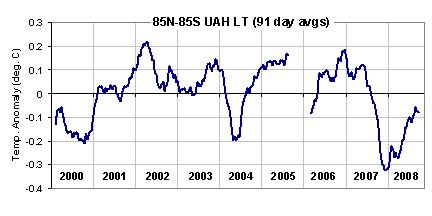From Watts Up With That?: As I work on finishing our forcing/feedback paper for re-submission to Journal of Geophysical Research – a process that has been going on for months now – I keep finding new pieces of evidence in the data that keep changing the paper’s focus in small ways. For instance, yesterday I realized that NASA Langley has recently updated their CERES global radiative budget measurement dataset through 2008 (it had previously ran from March 2000 through August 2007). I’ve been anxiously awaiting this update because of the major global cooling event we saw during late 2007 and early 2008. A plot of daily running 91-day global averages in UAH lower tropospheric (LT) temperature anomalies is shown below, which reveals the dramatic 2007-08 cool event. I was especially interested to see if this was caused by a natural increase in low clouds reducing the amount of sunlight absorbed by the climate system. As readers of my blog know, I believe that most climate change – including “global warming” – in the last 100 years or more has been caused by natural changes in low cloud cover, which in turn have been caused by natural, chaotic fluctuations in global circulation patterns in the atmosphere-ocean system. The leading candidate for this, in my opinion, is the Pacific Decadal Oscillation…possibly augmented by more frequent El Nino activity in the last 30 years. Now that we have 9 years of CERES data from the Terra satellite, we can more closely examine a possible low cloud connection to climate change. The rest here |
Saturday, September 26, 2009
The 2007-2008 Global Cooling Event - clouds the cause?
Subscribe to:
Post Comments (Atom)

No comments:
Post a Comment